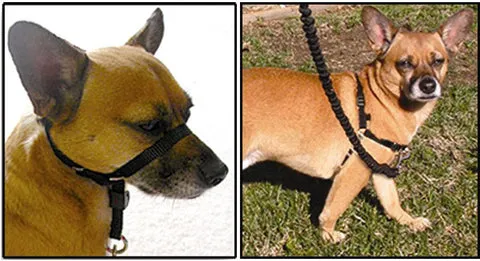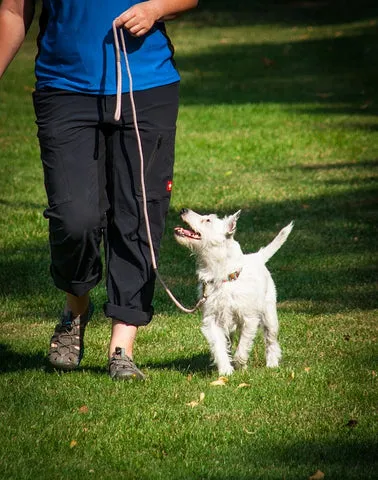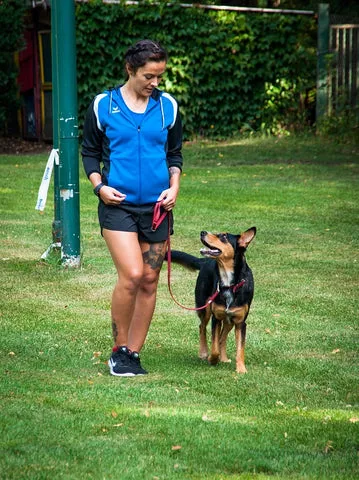Walking your dog should be an enjoyable experience for both of you, a serene stroll where your furry friend ambles happily by your side, stopping when you stop, turning when you turn, and confidently passing other dogs and people. The dream is a dog that doesn’t constantly tug on the leash and only sniffs or relieves himself when given permission. Mastering How To Leash Train Your Dog Not To Pull is arguably one of the most rewarding challenges you’ll undertake with your canine companion, yet it’s also incredibly fun and truly worth the effort! If you’re wondering how to train a dog to walk without pulling, this comprehensive guide will help you turn that vision into a reality, fostering a stronger bond and more pleasant walks.
 Small dog walking politely on a leash in a grassy park
Small dog walking politely on a leash in a grassy park
Essential Gear Before You Begin Leash Training
Before diving into the actual training, choosing the right equipment can significantly aid your success in teaching your dog polite leash manners and ensuring they don’t pull. While training is essential for your dog to learn to walk beside you without pulling at all, certain tools can provide immediate relief and better control.
A front-attachment harness is an excellent, user-friendly, and safe no-pull device suitable for most dogs. Unlike traditional harnesses that encourage pulling from the back, a front-attachment design redirects your dog’s forward momentum to their side, making pulling less effective. For dogs with aggressive tendencies or for handlers needing maximum control—such as a smaller owner with a large breed dog—a head collar for dogs offers superior management. These devices gently guide your dog’s head, and where the head goes, the body follows, making it easier to manage strong pullers.
 A tan dog wearing a head collar on the left, and a front-attachment harness on the right
A tan dog wearing a head collar on the left, and a front-attachment harness on the right
It’s crucial to remember that both front-attachment harnesses and head collars should only be used with leashes that are a maximum of 6 feet long. A longer leash can allow your dog to gain too much speed, potentially causing injury if they abruptly reach the end of the leash. Focusing on how to leash train your dog not to pull effectively means using the right tools in conjunction with consistent training techniques.
The “Stop and Reward” Technique for Loose Leash Walking
One of the most straightforward and effective methods to teach your dog not to pull on the leash involves a simple principle: stop moving forward when your dog pulls, and reward them generously when they walk politely by your side. This technique directly communicates that pulling leads to no progress, while loose-leash walking earns them rewards.
A treat bag worn on your waist can be incredibly helpful for quick and timely rewards during the training process. High-value, pea-sized treats like fresh meat or cheese work best to capture and maintain your dog’s attention. If your dog isn’t highly food-motivated, consider using a favorite tug toy, chew toy, or a tossed ball as an alternative reward. The goal is to make walking beside you more rewarding than pulling. This positive reinforcement approach is key to understanding how to stop a dog pulling on its lead and fostering a positive association with the leash.
Step-by-Step Guide to Leash Training Your Dog
Learning how to leash train your dog not to pull involves breaking down the process into manageable steps, building confidence and good habits gradually. These detailed steps will guide you in training your dog to walk politely on a leash.
Step 1: Making Walking with You a Delicious Experience!
Begin your loose-leash training in a familiar, low-distraction outdoor area like your backyard. Attach your dog to a long rope or a non-retractable leash (10-20 feet initially) while they wear a standard harness. Have your high-value treats ready.
First, decide which side you prefer your dog to walk on (the left is traditional). You will consistently deliver treats to your dog at your thigh on this chosen side. This consistency helps your dog learn that the “reward zone” is right next to you. Start walking briskly and randomly around your yard. Whenever your dog chooses to walk beside you, offer enthusiastic praise and a treat right at your preferred thigh. If they continue to walk calmly by your side, reward them every few steps. As they improve, you can gradually reduce the frequency of rewards. If your dog shows little interest, try again later when they might be more hungry. This initial step reinforces the idea that staying close to you brings positive outcomes.
Step 2: “Let’s Go” – Encouraging Your Dog to Follow
This step focuses on teaching your dog to pay attention to your direction and willingly follow you. While walking in your yard, wait for a moment when your dog is distracted, sniffing, or lagging behind. In an upbeat voice, say “let’s go,” and the first few times, you can slap your thigh to ensure they notice you, then turn and walk in the opposite direction.
When your dog catches up, reward them immediately with praise and a treat at your preferred side. If they continue to stay with you, reward them every couple of steps. If they catch up quickly, offer an extra reward. If the leash is tight and they aren’t coming towards you, stop walking and apply gentle, consistent leash pressure. This pressure serves as a reminder, not a force. The moment your dog shows any sign of moving towards you, release the pressure and praise them. When they reach you, reward them as before. Practice this until your dog consistently returns to your side when you say “let’s go.” Building a solid “let’s go” command is crucial for managing unexpected pulling. This also helps in establishing general obedience, much like how to teach dog stay and come commands are foundational for recall and control.
Step 3: Controlled Sniff Breaks and Potty Time
Dogs naturally need time to sniff and relieve themselves on walks. However, to foster better leash manners, you should decide when these opportunities occur. Approximately every five minutes during your training, at a time you would typically give a food reward, instead say something like “go sniff” and allow your dog to explore or go potty on the leash.
This “free time” is a privilege. If your dog begins to pull during this period, promptly say “let’s go” and walk in the opposite direction, immediately ending the sniff break. When you’re ready to resume polite walking, simply say “let’s go” and begin walking. This teaches your dog that good behavior earns them rewards, including the freedom to explore, while pulling ends the fun.
Step 4: Increasing Challenges and Reducing Rewards
Continue practicing steps one through three in your yard, gradually transitioning to a shorter leash, eventually reducing it to 6 feet. Introduce variations in your walking pace—practice walking extra fast or slow, and incorporate frequent stops and changes in direction. Reward your dog consistently if they can maintain their position by your side during these challenges.
As your dog becomes more proficient at walking politely, you can begin to reward less frequently for normal, consistent loose-leash walking. However, continue to provide high-value, immediate rewards when they stay by your side during more challenging scenarios, such as when you change pace unexpectedly or encounter a distraction like another animal or person. This helps them generalize their good behavior to more demanding situations.
 White dog on a leash, attentively watching its owner during a training session
White dog on a leash, attentively watching its owner during a training session
Taking Leash Training to the Street
Once your dog demonstrates consistent polite walking in your yard, it’s time to apply these techniques to real-world environments. On your neighborhood walks, you’ll encounter a host of new distractions, such as friendly strangers, squirrels, and other dogs.
For these initial outings, consider using a front-attachment harness or head collar for additional control, and bring your highest-value treats (fresh meat or cheese) to maximize motivation. Say “let’s go” and start walking. If your dog forgets their manners or begins to pull, immediately say “let’s go” and turn and walk in the opposite direction. Reward them with treats when they walk calmly beside you. Remember to give extra treats when it’s extra difficult for them to focus on you. Don’t forget to offer those authorized sniff breaks, especially when leash training a puppy, as it’s crucial for their development and enjoyment.
 A woman walking with an attentive black and tan dog on a leash through a park
A woman walking with an attentive black and tan dog on a leash through a park
Challenging Your Dog During Leash Training
To solidify your dog’s understanding of how to leash train your dog not to pull, introduce controlled challenges. Outfit your dog in a standard harness with a 6-foot leash. Hold the leash and toss a ball or treat about 20 feet away from you and your dog.
If your dog pulls towards the object, immediately say “let’s go” and turn and walk in the opposite direction. If they walk politely beside you as you approach the object, allow them to continue until they reach it and can claim it as their reward. Initially, you might want to use a longer leash or a less desirable object to make this exercise easier. This teaches your dog impulse control and that polite behavior, not pulling, leads to desired outcomes. These advanced exercises contribute to a well-rounded training regimen, much like teaching best tricks to teach a dog helps in improving overall obedience and mental stimulation.
Troubleshooting Common Leash Pulling Issues
Even with consistent training, you might encounter specific challenges. Here’s how to address them:
- Dog crossing in front of you: If your dog frequently cuts across your path, stomp or shuffle your feet slightly to make your presence more obvious and encourage them to stay to one side.
- Lagging behind: If your dog lags significantly, they might be frightened or unwell. Use plenty of encouragement rather than pulling them along. If they are lagging to sniff or potty, simply keep walking, applying only gentle, consistent pressure on the leash. Always remember to use abundant rewards when they walk with you.
- Alternating between walking beside you and pulling: If your dog consistently alternates between good behavior and pulling, stop rewarding them for simply coming back to you after pulling. Instead, focus your rewards on longer sequences of consecutive steps taken politely by your side. This helps them understand that sustained good behavior is what earns the treats.
 Small white and brown dog on a leash in the snow, looking back at its owner
Small white and brown dog on a leash in the snow, looking back at its owner
Introducing the “Heel” Command
Training your dog to heel is a valuable skill for specific situations when you need them to be very close and attentive to you, such as when passing other animals or navigating crowded areas. While separate from general loose-leash walking, it complements your overall goal of how to leash train your dog not to pull.
Start practicing “heel” in a low-distraction environment like your home. Hold a treat in your fist and let your dog sniff it. Say “heel” or “let’s go,” and take a couple of steps, leading your dog along with the treat near your thigh. Praise and reward them with the treat when they follow your fist with their nose. Next, practice having your dog follow your empty fist, continuously praising and rewarding them for every couple of steps they follow. Gradually increase your standards with each session. Your closed fist will serve as a visual hand signal for “heel.” Once proficient indoors, extend this practice to outdoor settings and more distracting circumstances. This command is an important tool for maintaining focus, similar to managing distractions like how to stop dog barking when someone comes in.
Conclusion
Successfully teaching your dog polite leash manners transforms walks from a struggle into a joyful shared activity. By consistently applying the “Stop and Reward” method, gradually increasing challenges, and using the right equipment, you can master how to leash train your dog not to pull. Remember, patience, consistency, and positive reinforcement are your most powerful tools. Enjoy your more harmonious and fun walks with your well-behaved canine companion!
